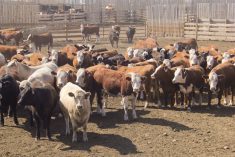Demand for Canadian pork products from South Korea may be slowing down, but the total volume of exports is still expected to remain steady, to slightly higher in calendar year 2012.
South Korea imported a lot of Canadian pork products in 2011 following that country’s outbreak of foot and mouth disease — but it’s not expected to be such a big customer in 2012, said Martin Charron, vice-president of market access and trade development for Canada Pork International.
"Their pork production is starting to recover to where it was," he said.
Read Also

U.S. livestock: Feeder cattle hit contract highs on tight supply
Chicago | Reuters – All Chicago Mercantile Exchange feeder cattle futures and most live cattle futures hit contract highs on…
South Korea is also importing more pork products from Canada’s competitors, the U.S. and Europe.
"The fact that Europe and the U.S. have negotiated a free trade agreement with South Korea, and Canada has not, means Canadian pork will be more expensive for South Korea," Charron said. "Tariffs on European and U.S. pork will be reduced, while tariffs on the Canadian pork remain stable."
Martin Rice, executive director of the Canadian Pork Council, expects that demand from other countries for Canadian pork products will help export numbers stay steady, or even see a slight increase in 2012.
"It looks like our exports to Australia are strong, as is the case for South Africa," he said. "And, exports to the U.S., Japan, Russia, China and Mexico are pretty much running at the same pace as last year."
Rice estimated that Canada will export about 1.175 million tonnes of pork products in 2012, compared to 1.151 million tonnes in 2011.
However, pork product prices have been experiencing a downward trend because of the slowing export demand from South Korea, Rice said. Expectations were for prices to go up, as sales were stronger in the earlier part of the year.
"Circumstances"
Weak North American demand is also responsible for some of the price softening, he said.
"The economic situation, particularly in the U.S., has been a little lacklustre and there’s a lot of economic uncertainty out there for people," he said. "It’s affecting the psychology of consumers and it doesn’t seem to be very favourable for the meat sector."
Domestic demand is also sliding as Canadian processors are importing more pork products from the U.S., Rice said.
Because the U.S. has the ability and volume to supply processors with meat year-round, they’re more attracted to importing meat from the U.S. rather than taking a chance on Canadian producers, who don’t always have the volume to fill domestic demand, he said.
Canadian producers find it difficult to juggle their domestic and export markets. Canada, he said, exports about 70 per cent of its product now, and doesn’t foresee an increase in production to better service domestic demand.
"The economic circumstances do not favour a sustained recovery in our growth or our production," he said.
Current Canadian slaughter production is at about 375,000 pigs a week. This number indicates that there is unused slaughter capacity in Canada, particularly in Alberta, Rice said.
— Terryn Shiells writes for Commodity News Service Canada, a Winnipeg company specializing in grain and commodity market reporting.
Related story:
Pork exports set new 2011 record, 2012 seen down, April 20, 2012















